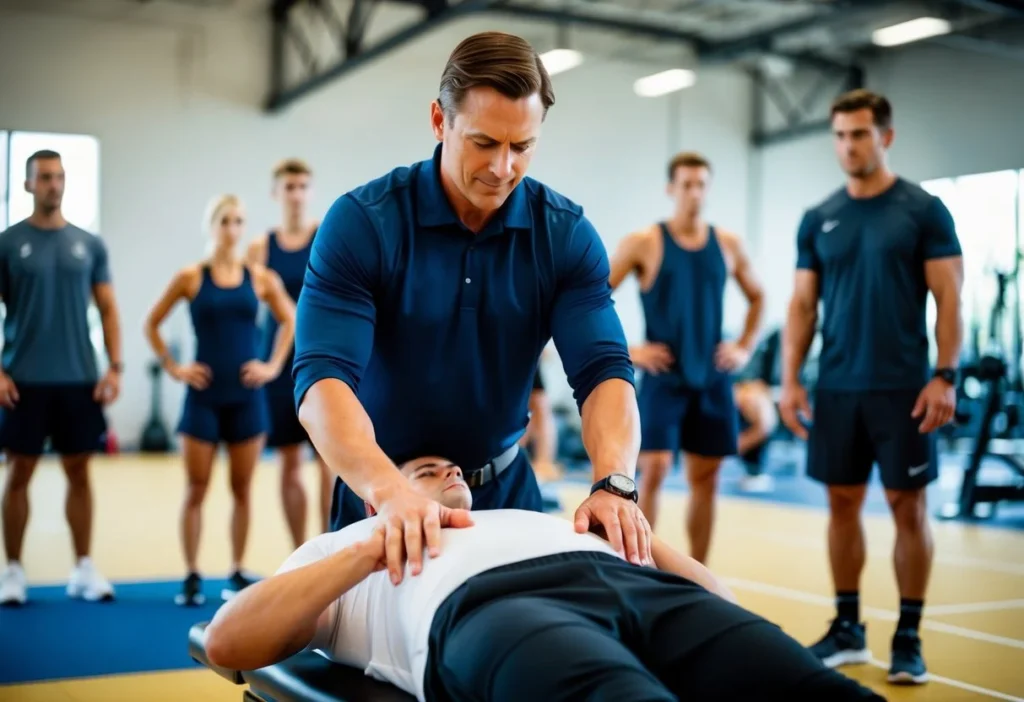Athletes continuously seek ways to enhance their performance and expedite recovery. The integration of chiropractic care into the sports industry offers a promising avenue to achieve these goals. Chiropractic care can significantly improve athletic performance through enhanced mobility, reduced pain, and quicker recovery times.
With an increasing number of professional athletes and sports teams embracing chiropractic services, the relationship between sports and chiropractic care is becoming more evident. Chiropractors focus on musculoskeletal health, helping athletes maintain optimal alignment and prevent injuries that could hinder their careers. This proactive approach ensures that athletes can train harder and compete more effectively.
Moreover, chiropractic care is not limited to injury treatment; it also plays a crucial role in enhancing overall wellness. By incorporating chiropractic into their training regimens, athletes can experience improved physical function and endurance. This holistic method is transforming how performance is optimized in the world of sports.
The Role of Chiropractic Care in Sports
Chiropractic care plays a vital role in enhancing athlete health, performance, and recovery. By integrating chiropractic methods, sports professionals can optimize their physical condition and reduce the risk of injuries.
Promoting Athlete Wellness and Performance
Chiropractors focus on the musculoskeletal system, ensuring proper alignment and function. This care helps athletes maintain balance, flexibility, and strength.
Regular adjustments can aid in:
- Reducing muscle tension
- Improving range of motion
- Enhancing overall mobility
Athletes often experience high levels of stress on their bodies. Chiropractic care can also promote mental wellness, leading to improved focus during training and competitions. Techniques such as stretching and soft tissue therapy complement spinal adjustments. This holistic approach supports an athlete’s ongoing performance.
Injury Prevention and Rehabilitation
Injury prevention is a primary focus of chiropractic care in sports. Chiropractors analyze an athlete’s movement patterns and biomechanics to identify potential issues before they lead to injuries.
Key strategies include:
- Customized exercise programs
- Posture and alignment assessments
- Education on proper techniques
In the event of injury, chiropractors provide rehabilitation strategies tailored to the individual. They implement treatments that promote healing and reduce recovery time. Integrative methods, such as physical therapy modalities alongside chiropractic adjustments, ensure a comprehensive approach to recovery. This attention to injury management enables athletes to return to their sport stronger and more resilient.
Chiropractic Techniques and Their Application in Sports
Chiropractic care employs various techniques that can enhance athletic performance and facilitate recovery. Key methods include spinal manipulation, soft-tissue therapies, and rehabilitative assessments, all tailored to address the unique needs of athletes.
Spinal Manipulation
Spinal manipulation is a foundational chiropractic technique that involves the application of controlled force to spinal joints. This method aims to restore proper alignment and improve range of motion.
Athletes often experience spinal misalignments due to intense physical activity. Correcting these issues can lead to enhanced performance, reduced pain, and quicker recovery.
Research shows that spinal manipulation can also alleviate tension in surrounding muscles, promoting overall spinal health. As a result, athletes may experience improved posture and balance, crucial for many sports disciplines.
Soft-Tissue Therapies
Soft-tissue therapies focus on the muscles and connective tissues surrounding the joints. Techniques such as myofascial release and trigger point therapy help alleviate muscle tightness and improve circulation.
These therapies can be particularly beneficial for athletes, addressing pain and preventing injuries. Improved flexibility leads to better overall performance during training and competition.
Integrating soft-tissue therapies into an athlete’s routine can also facilitate quicker recovery between sessions. Enhanced blood flow contributes to reducing inflammation and promoting healing, allowing athletes to train consistently.
Rehabilitative and Biomechanical Assessment Tools
Rehabilitation and biomechanical assessments are integral parts of chiropractic care for athletes. These tools help in identifying injuries and assessing movement patterns.
Chiropractors often use video analysis and specialized equipment to evaluate biomechanics. This facilitates tailored rehabilitation programs that address specific deficits.
By assessing an athlete’s movement, chiropractors can develop injury prevention strategies. This ensures that athletes maintain peak performance while minimizing risks during training and competition.
Integrative Approaches for Athletes
Incorporating chiropractic care into athletic training programs can provide holistic benefits. Collaboration with healthcare teams and adopting holistic care models are essential strategies for optimizing athlete performance and recovery.
Collaboration with Sports Medicine Teams
Chiropractors often work alongside sports medicine teams to enhance the care of athletes. This collaboration allows for a comprehensive approach to injury prevention and rehabilitation. By sharing expertise, they develop tailored treatment plans that address each athlete’s specific needs.
Regular communication between chiropractors and sports medicine professionals ensures that all aspects of an athlete’s health are monitored. This integrated approach can lead to improved outcomes and faster recovery times. For example, while chiropractors focus on spinal alignment and joint function, sports medicine teams might address nutrition and conditioning.
The incorporation of a Spanish speaking clinic can also enhance communication with athletes from diverse backgrounds. This accessibility fosters inclusive care, vital for maximizing athlete potential and promoting overall well-being.
Holistic Care Models
Holistic care models emphasize the connection between physical, mental, and emotional health in athletic performance. Chiropractors play a crucial role by addressing musculoskeletal issues while also considering the athlete’s lifestyle and stress levels.
In these models, practitioners may incorporate techniques such as:
- Nutritional counseling
- Stress management strategies
- Mindfulness and relaxation practices
Athletes benefit from these integrated approaches, which enhance performance and resilience. Emphasizing mental health alongside physical care can lead to better focus and motivation during training and competitions. By utilizing these holistic care models, chiropractic care can significantly contribute to an athlete’s overall health and success in their sport.
Case Studies and Outcomes
Chiropractic care has shown significant benefits in both professional and amateur sports settings. Specific case studies highlight the effectiveness of chiropractic in enhancing athletic performance and promoting recovery.
Professional Athletes and Chiropractic Success Stories
Many professional athletes have integrated chiropractic care into their training regimens. For instance, a well-known NFL quarterback underwent chiropractic adjustments during the season. This treatment focused on spinal alignment and reducing nerve interference, which improved his throwing precision and mobility.
Another example involves a professional basketball player who sustained recurring lower back injuries. Regular chiropractic sessions led to decreased pain levels and enhanced flexibility, resulting in a more robust performance on the court. Studies indicate that 90% of athletes report improved recovery times with chiropractic adjustments, underscoring its role in professional sports.
Amateur Sports and Community Impact
Chiropractic care is also pivotal for amateur athletes. Local sports teams frequently utilize chiropractors to address injuries and enhance overall performance. For example, a youth soccer team participating in tournaments benefited from chiropractic assessments that identified and corrected biomechanical issues.
In community settings, chiropractic clinics have hosted workshops to educate young athletes on injury prevention and proper mechanics. These initiatives not only improved physical outcomes but also fostered a culture of health and wellness within the community. Participants often report feeling more resilient and confident in their abilities after receiving care.
Navigating the Sports Industry
Successfully integrating chiropractic care within the sports industry requires strategic relationship-building and an awareness of legal and ethical considerations. Understanding these aspects is crucial for practitioners aiming to make a meaningful impact.
Building Relationships with Athletic Organizations
Establishing connections with athletic organizations is essential for chiropractors. Engaging with teams, coaches, and athletic directors opens avenues for collaboration.
Key strategies include:
- Networking: Attend sports events and conferences to meet key players.
- Education: Offer workshops or seminars on the benefits of chiropractic care to athletes.
- Partnerships: Create mutually beneficial partnerships, such as providing on-site services during events.
Developing trust and credibility within the sports community enhances visibility and fosters a deeper understanding of chiropractic care’s value for athlete performance and recovery.
Legal and Ethical Considerations
Navigating the sports industry’s legal landscape is critical for chiropractors. Practitioners must adhere to state regulations, licensing requirements, and ethical guidelines related to patient care.
Important points include:
- Informed Consent: Athletes should fully understand and consent to chiropractic treatments.
- Collaboration: Work alongside medical professionals to ensure comprehensive care.
- Confidentiality: Protect patient privacy in compliance with applicable laws.
Awareness of these factors helps chiropractors maintain professionalism and integrity while delivering effective care to athletes.
Future Perspectives of Chiropractic in Sports
The future of chiropractic care in sports shows promising developments in emerging trends, technologies, and a push for global expansion and inclusivity. Addressing specific needs of diverse athletes and integrating advanced practices is essential for enhancing performance and recovery.
Emerging Trends and Technologies
As sports science evolves, chiropractic care is integrating new technologies like biomechanics analysis and virtual reality rehabilitation. These advancements help practitioners assess athletes more precisely, enhancing treatment plans based on real-time data and individual biomechanics.
Telehealth services are also becoming vital. They allow chiropractors to provide remote consultations, making care accessible to athletes in various locations, including Spanish-speaking communities. This expansion enables timely interventions, ultimately promoting athlete health.
Furthermore, wearables that track physical metrics will empower chiropractors to customize care. They can better predict injuries and monitor recovery, which will lead to strategies that bolster athletic performance and longevity.
Global Expansion and Inclusivity
Chiropractic care is increasingly recognized worldwide, especially in sports settings. This acceptance leads to broader integration into athletic programs internationally. Notably, clinics catering to Spanish-speaking athletes are emerging, addressing language barriers and adapting practices to cultural needs.
As more organizations prioritize diversity, chiropractors are encouraged to engage with underrepresented athletes. This inclusivity fosters a more comprehensive approach to care that respects varied backgrounds and experiences, ultimately enhancing team dynamics and performance.
Collaborations between sports teams and chiropractic organizations are likely to grow. These partnerships will aid in training programs that educate athletes about the benefits of chiropractic care, reinforcing its importance in the athletic world.







